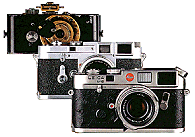.
Successful street photography only comes with practise and much film sacrificed on early attempts. The street photographer must possess the ability to be discreet, along with the need to have fast physical reflexes over himself and his equipment, and accordingly, the mental reflexes to recognize a good picture quickly.
Henri Cartier Bresson (HCB), the most famous practitioner of the craft, was often described as unassuming and able to blend into places with consummate skill. It was this quality that allowed him to capture the many famous photographs that he is known for today, photographs that seemed to have been made by an invisible witness, with their subjects not knowing of the photographer's presence. He coined the term "The Decisive moment", and described the trance like process of obtaining a photograph, where he is immersed in his surroundings, waiting to capture the moment that arrested and defined the event that was being captured.
It would no doubt have helped that HCB was simple in his choice of equipment. A tiny rangefinder with 2 to 3 lenses, with the 50mm becoming his favored tool, since it retained the natural perspective of the eye. The relative shortness of this lens often required that he be close to his chosen subject. It is by this fact that we realize what an incredible feat it must have been to be able to photograph at close quarters without people knowing that they were being photographed.
Therefore it is good to keep in mind the value of simplicity in the choice of equipment. One of the reasons why many street photographers like HCB, and others I have mentioned adhere to the rangefinder Leica lies in the fact that unlike an SLR, Leicas are extremely silent. Instead of the loud clunk that is associated with SLR's, the Leica's only concession in terms of decibels is a soft click. This is extremely valuable when you consider that a noisy camera is one of the ways that a photographer's presence can be realized. Leica's are also comparatively smaller, making them more cancelable and less of an attention grabber. The other advantage is the supremely high quality of their lenses whose quality is constantly raved about by its users.
Leicas for being what they are, are expensive cameras however, and beyond the reach of many people. In the light of this, there are other viable options such as the Minox 35 series or the Konica Hexar, an electronic variant of the Leica. These examples are similar in the respect that they are compact and also silent in operation.
Street photography of people at close quarters begs simplicity and therefore requires one to be discreet. When one is weighed down by a bulging camera bag, with a shiny tripod hung on the side, and a massive SLR with flash on top, people will have no difficulty in recognizing that you are a photographer. Not only that, your speed of operation will may be compromised when you are busy juggling the weight of your equipment. Ideally, a compact and silent rangefinder with a few lenses, those not in use stuffed in a pocket or kept in a non-photographic looking bag. In keeping with the desire to be discreet, clothes and mannerisms should also not regularly invite recognition or comment.
Other things that may be done include wrapping the strap around the arm holding the camera. This prevents any loose ends from waving around and catching people's attention. Practically also, in the throng of a crowd when one's attention is on what is in front of you rather than on the potential theives around, keeping the strap around your arm will make it difficult for anyone to grab at your camera.
In terms of exposure and focus, if using a manual camera, always take note of the changes in exposure when you enter places of differing light levels. For instance, when entering a building from the daylight, make it a point to notice that the exposure setting for the outside is no longer relevant to the new condition you are in. being prepared in this manner will no doubt save the agony of missing that shot.
 The original "Ur" Leica, M3 and M6
The original "Ur" Leica, M3 and M6